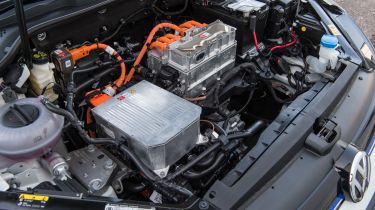Volkswagen e-Golf (2014-2019) electric motor, drive & performance
Extra battery weight dulls the e-Golf’s handling, but it’s still a creditable performer compared to rivals
| 0-62mph | Top speed | Driven wheels | Power |
|---|---|---|---|
| 9.6s | 93mph | Front | 135bhp |
To cope with a pretty hefty battery pack stashed under the boot floor, Volkswagen put stiffer springs on the e-Golf. It’s noticeably less agile than non-electric versions, and comfort suffers a little, too. Nonetheless, the e-Golf’s ride, handling and performance make it a pleasure to drive.
Volkswagen e-Golf electric motor, 0-62mph and acceleration
The e-Golf has a 134bhp electric motor, which powers the front wheels through a single-speed ‘direct drive’ transmission. The instantaneous response typical of electric motors translates into a car that feels very perky from a standing start, cracking the benchmark 0-62mph sprint in 9.6 seconds.
Up to about 35mph the e-Golf accelerates quicker than the Golf GTI hot hatchback, so you’ll have no complaints about its responsiveness when nipping out at busy junctions, for example. Out of town and especially at motorway speeds, the e-Golf performance feels less energetic, but never out of its comfort zone. You get to choose from three driving modes (Normal, Eco and Eco Plus), with the available power reducing at each stage to help maximise range.
Even diesel Golf models are extremely refined when it comes to engine and road noise, so it’s no surprise the electric version is as quiet as a whisper, even under acceleration. In fact, the driving experience feels so ‘normal’ that the quiet progress is one of the few giveaways that you’re behind the wheel of an electric car.
The other is regenerative braking, which harvests extra charge for the battery when you slow down. It means you slow faster just by lifting off the accelerator, and in many situations don’t need to use the brake pedal at all – a feature that can take a little getting used to.
Handling
The batteries in the boot of an e-Golf weigh 318kg, which is a lot of extra mass to deal with when the car is in motion. You can feel the weight in the back if you try to throw the e-Golf around in corners, and while the tyres are grippy enough, the chassis doesn’t respond well when treated that way.
There’s more body lean than you’d like, and the car lurches around bends instead of flowing with them. Ease off the pace a little, though, and the e-Golf handles with the same reassuring competence of other models in the Golf line-up.
Coupled with the extremely hushed interior, this should add up to a seriously refined way to travel, but unfortunately the need for stiffer springs to handle the extra weight has rather blighted the Golf’s usually highly rated ride quality. The e-Golf is a bit jittery, especially on potholed urban roads here in the UK, and that’s something of a disappointment.
